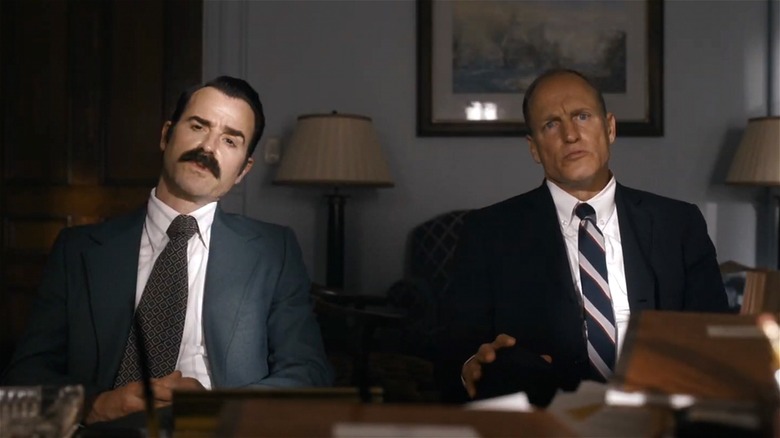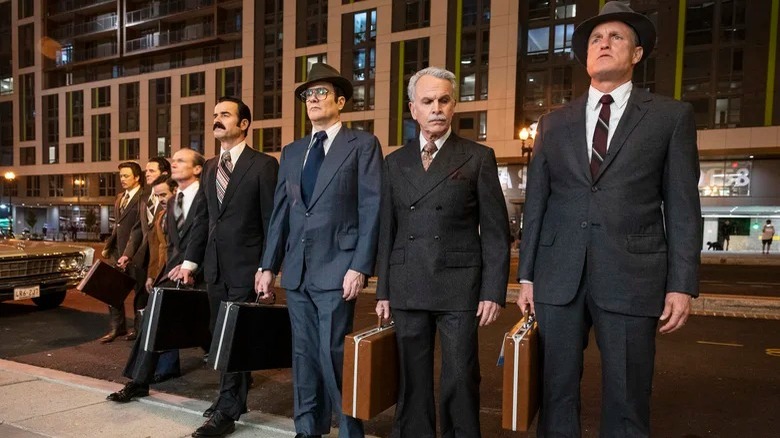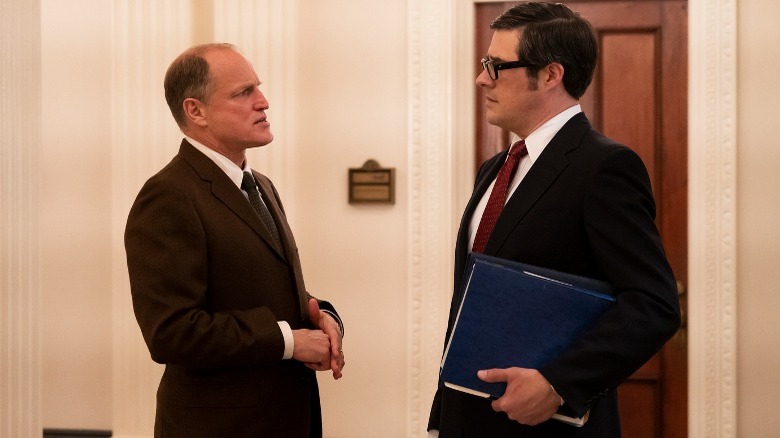White House Plumbers' Episode 1 Break-In Was Just As Chaotic In Real Life
This post contains spoilers for HBO's "White House Plumbers."
Countless pieces of media dedicated to the Watergate scandal have scrutinized the various facets of the infamous series of break-ins (and cover-ups) perpetrated by the Nixon administration. From the taut, thrilling "All the President's Men" to the chaotic satirical comedy "Dick," Watergate has been dramatized in various tints and shades, and the HBO limited series, "White House Plumbers," intends to continue this tradition. The show's attempts at comedy are half-decent — the colorful characters involved in the (repeated) attempted break-in into the National Committee offices are rightfully portrayed as bumbling clowns with massive egos, but the results are uneven, and not as entertaining as it intends to be. However, "White House Plumbers" does excel in capturing the utterly ridiculous chaos of the botched break-ins from the get-go, exposing the continued incompetence of the Plumbers that eventually led to the downfall of President Richard M. Nixon.
Before we dive into the break-in in question in episode 1, let's lay out some additional (and necessary) context for the event. The story of "White House Plumbers" mostly unfurls from the point of view of ex-CIA agent E. Howard Hunt (Woody Harrelson), who is seen increasingly approaching a downward spiral as the agency does not consider him an asset anymore. Opportunity arises in the form of a national political controversy when military strategist Daniel Ellsberg leaks the Pentagon Papers to the media, after which he is charged under the Espionage Act. Enter G. Gordon Liddy (Justin Theroux), an ex-FBI dude with whom Hunt must team up to gather "evidence" against Ellsberg to discredit his claims. Chaos ensues.
While the show fleshes out character quirks to heighten the real-life incompetence of Hunt and Liddy for comedic effect, details about the first break-in remain true to life. Here's what happened.
A ludicrous plan to begin with
Episode 1 of "White House Plumbers" opens with a fake-out, as we are led to believe that the Plumbers are in the midst of the major National Committee office break-in. However, those expectations are subverted when the gang realizes that they brought the wrong lock-picking tools (the right ones are back at home, the lockpicker says). It's enough to grant us an idea about the tone that the series is set to embody, and things get increasingly sillier in the flashback to the foundations of this covert operation. Both Hunt and Liddy are weirdos of the highest order and they place a lot of faith in their non-existent skills as covert operatives — all the while vibing together in their bubble of mirrored ineptitude after they're tasked with exposing Ellsberg.
Hunt and Liddy decide to break into Ellsberg's psychiatrist's office, confident that the whistleblower confided incriminating details during therapy (which they think are bound to be in his patient file). After scouting out the location in blatantly conspicuous disguises and managing to gather a layout of the office, the duo team up with a group of Cuban-American exiles that Hunt is acquainted with. These men, who call themselves expert burglars and operatives, chart out a laughable break-in plan without taking basic factors into consideration. To no one's surprise, they bungle their attempted break-in to an almost baffling degree.
While one would think that their real-life counterparts were sharper than these highly-satirical characters, this does not seem to be the case. Per a report by The Washington Post, the first break-in was the beginning of a series of ludicrous, careless attempts at political sabotage that was actually as poorly planned and handled as portrayed in HBO's limited series.
A bungled job
In his autobiography, Liddy said that the White House "wanted to destroy Ellsberg's status as a hero of the left-liberal establishment because his continuation in that role might lead others to emulate him." While this might've been the impetus behind the obsession with Ellsberg's patient file, the manner in which the break-in unfolded was messy from the start. Per this WP report, Hunt and Liddy flew out to Beverly Hills and wore disguises while posing as tourists near the location, and Hunt spoke Spanish to convince a cleaning lady to let them enter the psychiatrist's office. These details are incorporated into the show, although obviously exaggerated for comedic effect.
On September 3, 1971, Hunt, Liddy, and the Cuban gang carried out the break-in but found absolutely nothing on Ellsberg. In order to mask their break-in, they messed up the office to make it look like someone with a drug addiction had broken in to steal drugs — although the show portrays it as an accident where the burglars carelessly ransack the room. Things took an even more absurd turn in real life when Hunt used a CIA-sanctioned camera to take pictures outside of the office but returned it with the film still intact inside. Liddy even posed in front of their car, clearly revealing their license plate in the pictures.
Episode 1 concludes with this absurd error, which would later become part of a pile of evidence against the government's attempts to sabotage and suppress evidence in the Ellsberg case. Even before the break-in begins, the group is chaotically un-coordinated and clearly has no idea about what they are doing. It is not far-fetched to assume that even more outlandish shenanigans went down during the actual break-in in 1971.
The "White House Plumbers" premiere is now streaming on HBO Max.


